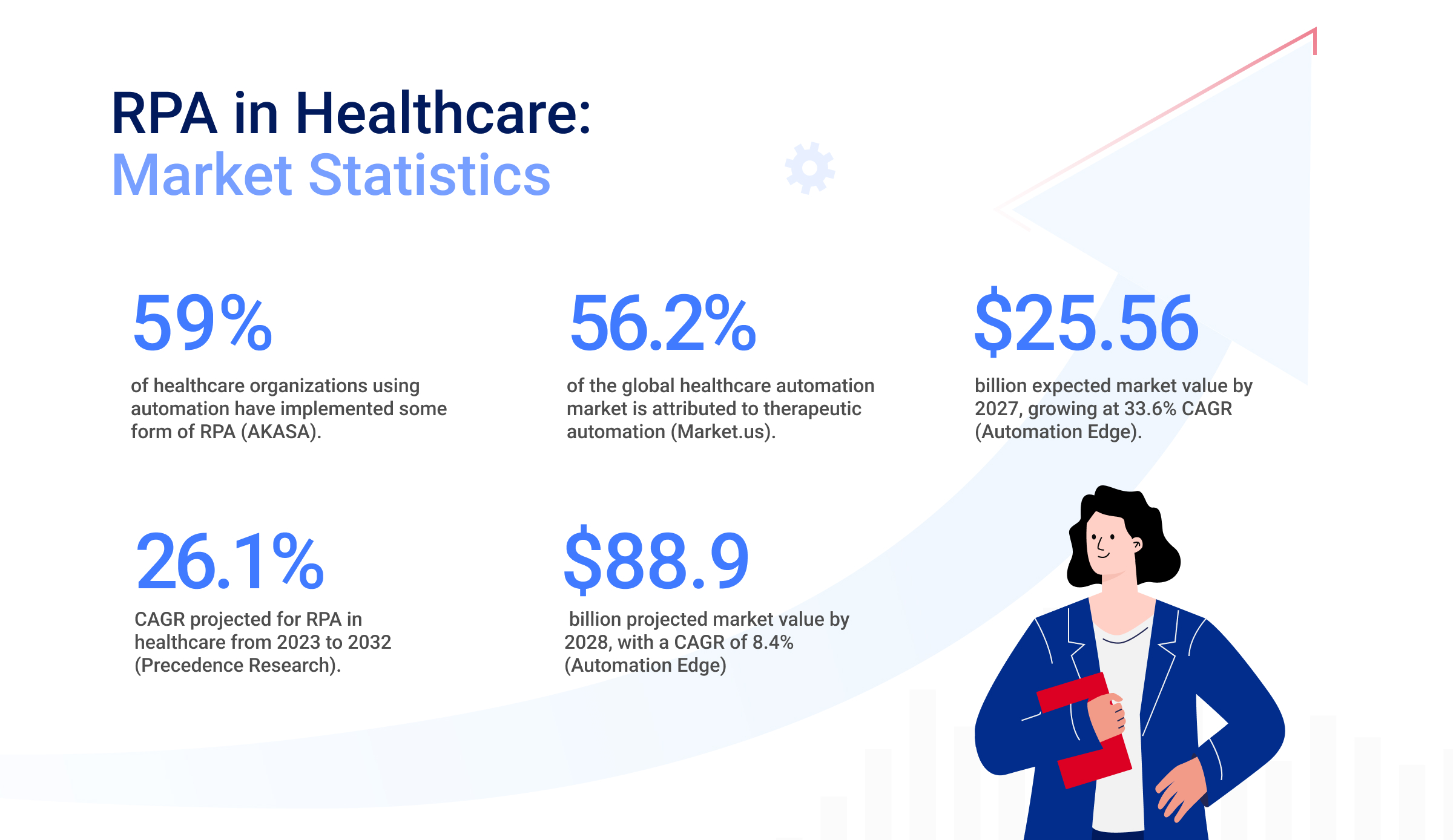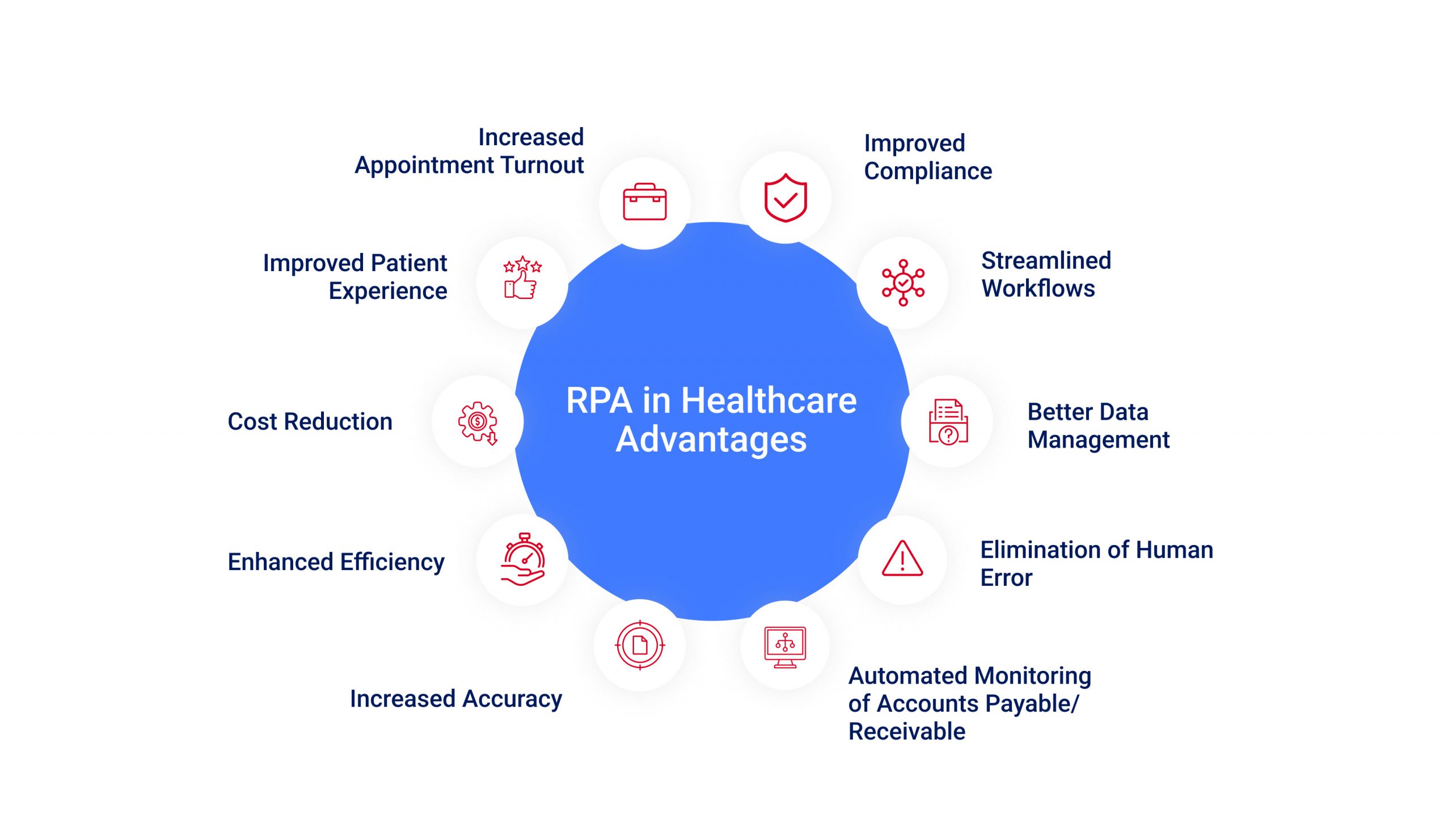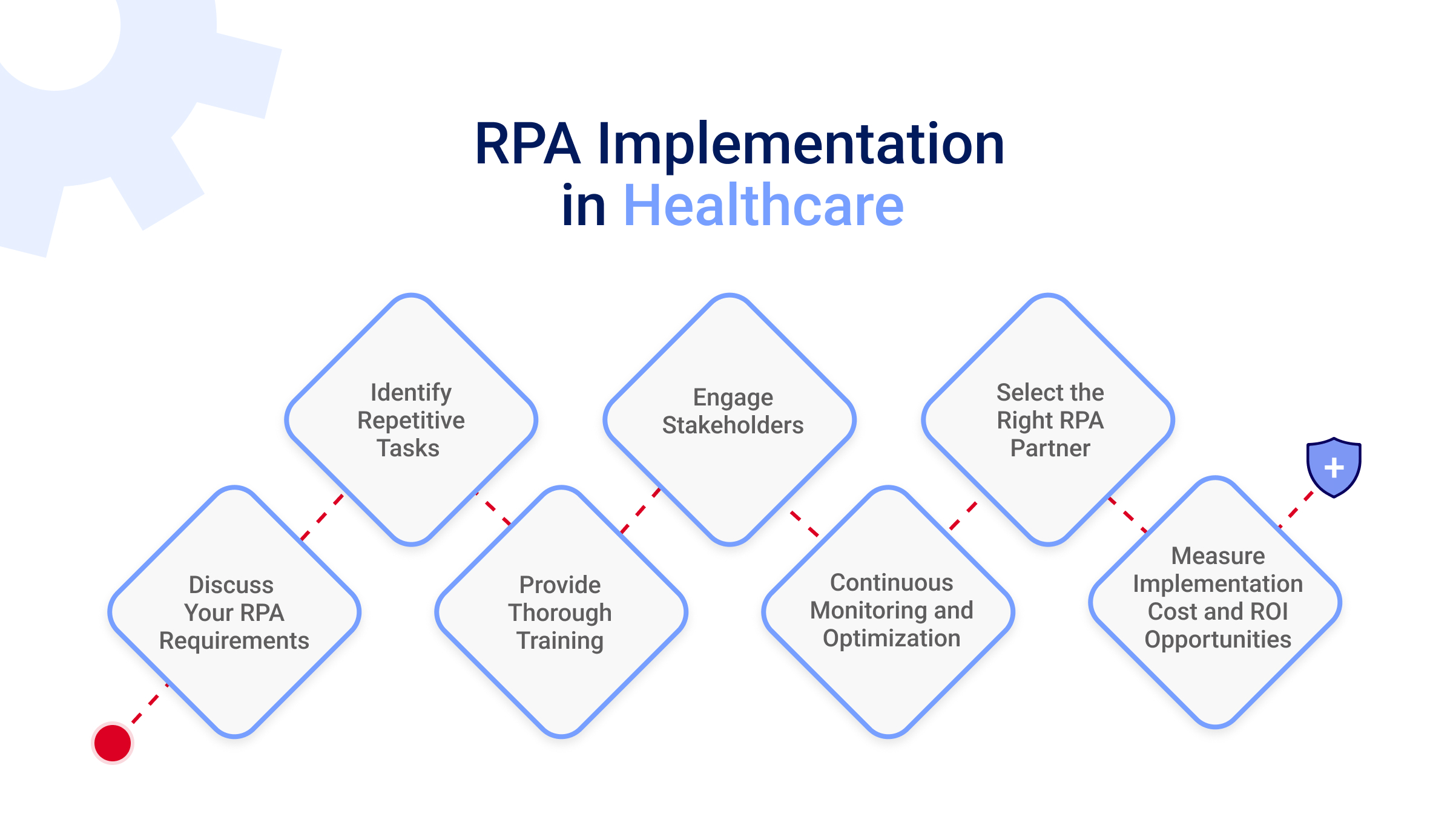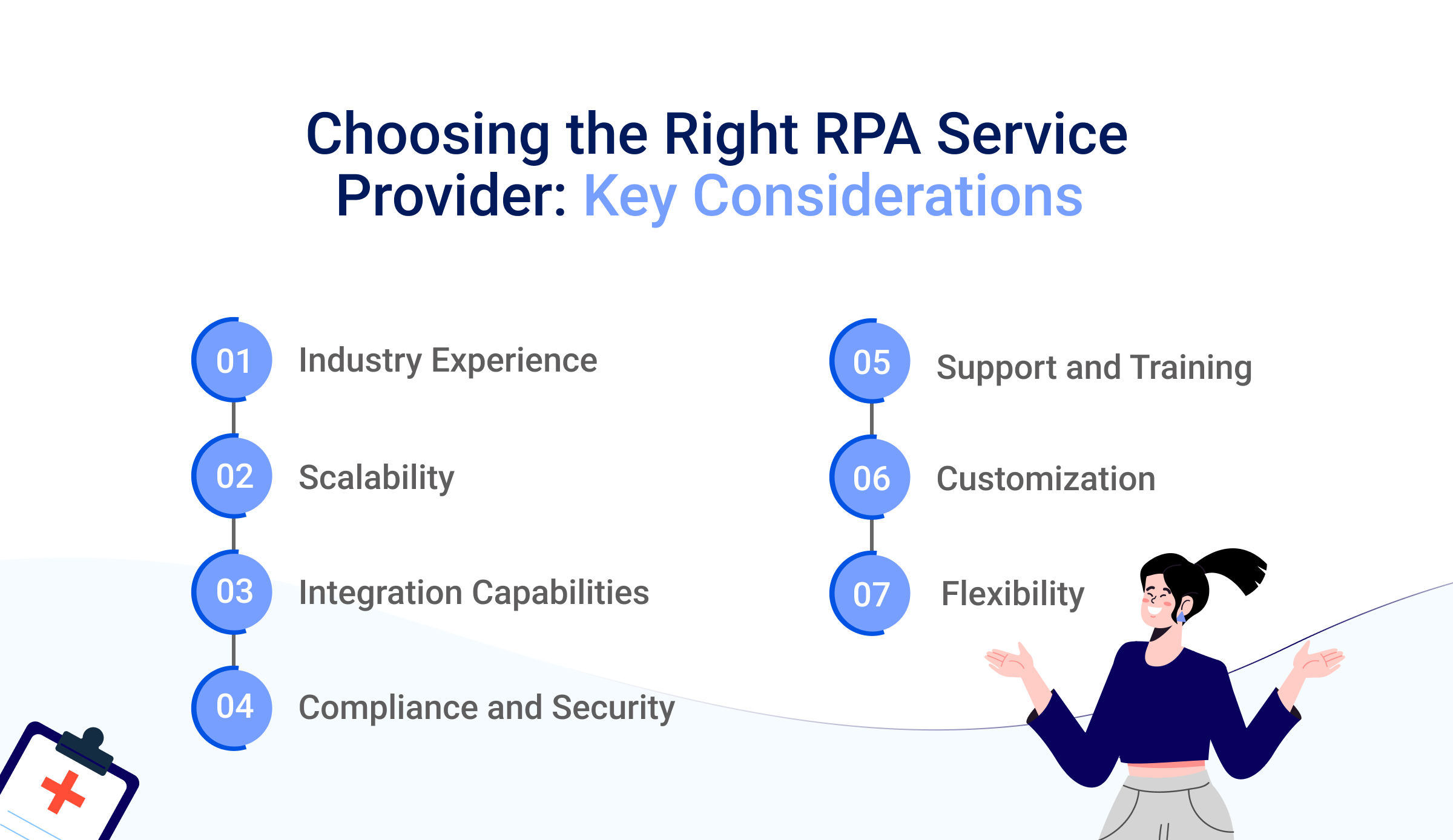RPA in Healthcare
BLOG
15 min read
RPA in Healthcare: Benefits, Use Cases, and Choosing the Right Partner
Robotic Process Automation (RPA) is making waves across various industries, and healthcare is no exception. Although healthcare might not be the first industry that comes to mind when you think of automation, RPA is reshaping how care is delivered. With the growing demand for faster, more accurate services, healthcare providers are turning to RPA to handle repetitive tasks, allowing staff to focus on what truly matters—caring for patients. Can you imagine if tasks like data entry, appointment scheduling, and claims processing could be automated? This would mean less time spent on paperwork and more time spent with patients, ultimately leading to better care and improved outcomes.
In this blog, we’ll take a closer look at what RPA is in healthcare, how the market is growing, the benefits it offers, real-life use cases, how to implement it, the challenges you might face, future trends, and tips for choosing the right partner for your RPA journey. Let’s explore how RPA can make a meaningful difference in healthcare!
Looking to learn more about RPA implementation in healthcare?
Talk to Our Experts Today!What is RPA in Healthcare?
Robotic Process Automation in healthcare refers to the use of software robots to automate routine tasks that are typically performed by human workers. These tasks can include data entry, appointment scheduling, billing, claims processing, and more. By automating these processes, healthcare organizations can reduce errors, save time, and enhance operational efficiency. For example, RPA can help digitize patient records, ensuring that information is not only accurate but also easily accessible to healthcare providers.
This automation allows staff to focus on providing quality care to patients rather than getting bogged down by administrative tasks. Times when healthcare demands are constantly increasing, RPA offers a practical solution to streamline operations and improve service delivery.
RPA in Healthcare Market
The RPA market in healthcare is experiencing significant growth. According to recent statistics, the global RPA market is expected to reach $25.56 billion by 2027, growing at a remarkable CAGR of 33.6%. This growth is driven by the increasing demand for automation in healthcare processes, as organizations seek to improve efficiency and reduce costs.

In fact, 59% of healthcare organizations using automation have adopted some form of RPA (AKASA), highlighting its widespread acceptance across the industry. Furthermore, a projected CAGR of 26.1% for RPA in healthcare from 2023 to 2032 (Precedence Research) indicates that the momentum for RPA is set to continue well into the next decade.
The market also shows that 56.2% of the global healthcare automation market is attributed to therapeutic automation (Market.us). This reflects a growing recognition of the importance of RPA in enhancing patient care and operational efficiency.
Moreover, the RPA in healthcare market is projected to grow at a CAGR of 8.4%, reaching a valuation of $88.9 billion by the end of 2028 due to increasing concerns about affordable healthcare access. This underscores the critical role that RPA will play in addressing the challenges faced by healthcare providers, such as rising patient volumes and the need for better data management.
As healthcare providers increasingly turn to RPA, it is becoming an essential tool in their operations, enabling them to streamline workflows, reduce administrative burdens, and ultimately enhance the quality of care delivered to patients.
Benefits of RPA in Healthcare
Implementing Robotic Process Automation in healthcare offers numerous advantages that can not only improve their operational efficiency but also enhance the quality of care they provide to patients. Here are some of the key benefits:

1. Cost Reduction
According to a publication by Alsbridge, automating claims processing can lead to substantial savings. A claim requiring human intervention costs approximately $4 to process, while an auto-adjudicated claim costs around $1. With over 3 billion healthcare claims filed each year, increasing auto-adjudication rates by just 10 to 12% could save the industry well over $1 billion. These savings can trickle down to healthcare providers and patients, allowing for more resources to be allocated towards patient care.
2. Increased Appointment Turnout
Many healthcare providers face financial losses due to missed appointments. By using RPA to automate scheduling and send appointment reminders, providers can maximize the number of patients seen each day, leading to increased productivity and efficiency.
3. Automated Monitoring of Accounts Payable/Receivable
RPA can enhance billing efficiency by automating the monitoring of accounts payable and receivable. This leads to quicker payments and reduced write-offs, improving the financial performance of healthcare providers.
4. Elimination of Human Error
Healthcare automation drastically reduces errors in data migration and digitization tasks. By automating the digitization of patient records, healthcare providers can maintain accurate and up-to-date records, which is crucial for effective treatment and care.
5. Improved Patient Experience
A positive patient experience is essential for healthcare providers. By automating time-consuming tasks like appointment scheduling and data entry, healthcare staff can focus more on patient care. This leads to shorter wait times and easier access to health records and billing information.
6. Enhanced Efficiency
RPA automates repetitive tasks, significantly reducing the workload on healthcare professionals. This allows them to focus on more critical and complex tasks, improving overall operational efficiency.
7. Increased Accuracy
RPA in healthcare minimizes human error, ensuring high accuracy in data entry, claims processing, and other critical tasks. This leads to better decision-making and enhanced patient outcomes.
8. Streamlined Workflows
RPA optimizes workflows by eliminating manual hand-offs and reducing delays. This results in faster turnaround times and a smoother healthcare delivery process.
9. Better Data Management
RPA facilitates smooth data integration and synchronization across various platforms, ensuring accurate and current patient records. This supports better patient care, as providers have access to reliable information when making clinical decisions.
10. Improved Compliance
RPA in healthcare helps maintain compliance with industry regulations by automating compliance-related tasks and monitoring access to sensitive information. This reduces the risk of penalties and breaches.
Top Use Cases of RPA in Healthcare
Robotic Process Automation (RPA) is transforming various aspects of healthcare by streamlining processes and improving efficiency. Here are some of the top use cases of RPA in the healthcare sector:
1. Revenue Cycle Management
RPA can automate the entire revenue cycle, from patient registration to claims processing. By streamlining these processes, healthcare organizations can reduce billing errors and improve cash flow. For example, a case study highlighted how RPA was used to automate utilization reviews and audit requests, significantly enhancing efficiency.
Read more about this case study here
2. Patient Scheduling
RPA can optimize appointment scheduling, reducing no-shows and cancellations. By automating reminders and confirmations, healthcare providers can improve appointment turnout and maximize patient visits.
3. Claims Processing
Automating claims processing reduces the time and effort required to manage billing. RPA can quickly verify claims, process payments, and handle denials, leading to faster revenue collection. A case study highlighted how RPA reduced healthcare processing time, improving overall efficiency.
Learn more about this implementation here
4. Data Entry and Migration
RPA can automate the transfer of data from paper records to electronic health records (EHRs), reducing the risk of errors and ensuring data accuracy. This is crucial for maintaining up-to-date patient information.
5. Process Discovery and Engagement
RPA assists in process discovery by identifying areas for automation and optimizing workflows. This leads to more effective healthcare automation solutions, allowing organizations to better allocate resources and improve service delivery.
Explore more about process discovery with RPA here
Read more: Use Cases for RPA in Managed Healthcare
How to Implement Robotic Process Automation in Healthcare
Implementing RPA in healthcare may seem challenging at first, but with a structured approach, it can be a smooth process that significantly enhances operational efficiency. Here are the key steps to get started:

1. Identify Repetitive Tasks
The first and foremost step in implementing RPA is to identify repetitive tasks within your healthcare organization. Focus on non-revenue generating functions and document each workflow in detail. Eliminate processes or tasks that do not add value and determine the short and long-term goals of your healthcare company. This groundwork is essential to harness the power of RPA effectively.
2. Engage Stakeholders
Involve key stakeholders such as healthcare providers, IT teams, and compliance officers. Their insights will ensure that the RPA solution aligns with organizational goals and meets compliance requirements.
3. Select the Right RPA Partner
Choose an experienced RPA provider who understands the unique challenges of the healthcare industry. A reliable partner will help you navigate the complexities of automation and ensure that the solution is scalable and compliant with healthcare regulations.
4. Discuss Your RPA Requirements
Work closely with your RPA partner to discuss your specific needs. Consider your current IT infrastructure and take a progressive approach to automation, starting with simpler tasks.
5. Provide Thorough Training
Ensure that your project managers and staff receive comprehensive training on the RPA tools. This will help build confidence and enthusiasm among employees, making the transition smoother.
6. Continuous Monitoring and Optimization
Once RPA is implemented, regularly monitor its performance. Make necessary adjustments to optimize workflows and ensure that the automation remains efficient and effective.
7. Measure Implementation Cost and ROI Opportunities
Assess the costs associated with RPA implementation against the savings it generates. Many healthcare organizations report achieving payback in as little as 12 months.
Continually measure the ROI to justify the investment and highlight the benefits to the organization.
Scaling RPA Solutions
Updating managed healthcare claim processing can be overwhelming for IT departments, especially when dealing with complex authorization requirements that vary by contract and provider. Traditionally, these tasks are handled manually, which can be expensive and prone to errors. RPA can automate many of these processes, using the claim system’s editing and routing capabilities alongside its own logic to streamline authorization validation.
The implementation of RPA can scale iteratively, starting with simple tasks like direct data correction and moving towards more complex applications, such as authorization processes and even cognitive technologies like Natural Language Processing (NLP) for handling medical review claims. This automation validates data, navigates various databases, and determines whether to pay, deny, or request further information.
Implementation Timeline and Cost
The entire RPA implementation process typically takes 2 to 8 weeks and can reduce labor costs by 40-80%. The overall cost of implementation ranges from $18,000 to $54,000.
Start Small and Scale Gradually
Sound complex? It’s not as difficult as it may seem. You can automate functions one step at a time. There’s no need to have all processes streamlined before implementing RPA; you can begin benefiting from automation without disrupting your current operations. This gradual approach allows for faster results and cost reductions while improving the client experience.
Remember, every technological advancement has its challenges. Just as people were initially doubtful about the introduction of spreadsheets, RPA represents the beginning of a new era in healthcare automation. Embracing RPA can lead to significant improvements in efficiency and patient care, paving the way for a more streamlined healthcare system.
Three Common Challenges of RPA in Healthcare
| Siloed Legacy Systems | Staff Resistance | Post-Deployment Issues |
|---|---|---|
| Healthcare organizations often have siloed IT ecosystems, which can hinder data extraction and task execution for RPA. To address this challenge, organizations should: | A common concern among employees is the fear that RPA will replace their jobs. To mitigate this resistance, management should: | After deployment, changes to automated processes—such as updates in regulations—can lead to RPA bots functioning inadequately. To prevent this, healthcare providers should: |
|
|
|
The Future of RPA in Healthcare
The future of Robotic Process Automation in healthcare looks promising, with several emerging trends that will shape the industry's automation landscape:
1. Intelligent Automation
The integration of artificial intelligence (AI) with RPA will enable more complex decision-making processes, further enhancing automation capabilities. By combining the rule-based task execution of RPA with the cognitive capabilities of AI, healthcare organizations can automate even more complex workflows, such as medical diagnosis and treatment planning.
2. Increased Focus on Patient-Centric Care
As healthcare providers adopt RPA, the focus will shift towards improving patient experiences and outcomes. By automating administrative tasks, healthcare staff can devote more time to patient care, providing a more personalized and attentive experience. RPA will also enable better data integration and analysis, allowing providers to make more informed decisions and deliver more effective treatments.
3. Expansion of RPA Use Cases
RPA will continue to evolve, with new use cases emerging across various healthcare functions, from supply chain management to telehealth. As the technology matures and becomes more widely adopted, healthcare organizations will find innovative ways to apply RPA to streamline their operations and improve patient care.
4. Increased Adoption of Cloud-Based RPA
Cloud-based RPA solutions are becoming more prevalent in the healthcare industry, offering greater scalability, flexibility, and cost-effectiveness. By leveraging cloud technologies, healthcare organizations can quickly deploy RPA bots and scale them up or down as needed, without the need for costly on-premises infrastructure.
5. Stronger Focus on Compliance and Security
With the increasing importance of data privacy and security in healthcare, RPA providers will focus on developing solutions that prioritize compliance with regulations like HIPAA. Healthcare organizations will demand RPA tools that offer robust security features, such as role-based access controls, audit trails, and encryption, to protect sensitive patient data.
How to Choose an RPA Service Provider for Healthcare Automation Solutions?
When selecting RPA services for healthcare industry, consider the following factors:

1. Industry Experience
Look for a company with a proven track record in healthcare automation and a deep understanding of industry-specific challenges and regulations.
2. Scalability
Choose a partner that offers scalable robotic process automation solutions that can grow with your organization's needs and adapt to changing requirements.
3. Integration Capabilities
The RPA solution should easily integrate with your existing healthcare systems, such as electronic health records (EHRs) and practice management software.
4. Compliance and Security
Ensure that the RPA provider offers solutions that comply with healthcare regulations, such as HIPAA, and maintain the highest standards of data security.
5. Support and Training
Look for a partner that provides comprehensive support and training to help your team successfully implement and maintain the RPA solution.
6. Customization
Choose a partner that offers customizable RPA solutions tailored to your organization's unique workflows and processes.
7. Flexibility
Select a partner that can adapt to your organization's changing needs and provide ongoing support and maintenance for the RPA solution.
Interested in understanding the cost implications of RPA implementation in your organization?
Let’s Discuss!Explore Endless Possibilities with RPA in Healthcare
As the healthcare industry continues to face challenges such as rising costs, increasing data volumes, and tight regulations, RPA offers a scalable and cost-effective solution to address these issues. By automating repetitive tasks and integrating seamlessly with existing systems, RPA enables healthcare providers to focus on what truly matters: delivering high-quality care to their patients.
The future of RPA in healthcare is bright, with exciting developments on the horizon, including intelligent automation and expanded use cases. By embracing this transformative technology, healthcare providers can experience new possibilities, enhance patient experiences, and shape the future of healthcare delivery. By partnering with a trusted RPA service provider, healthcare organizations can navigate the complexities of implementation, overcome challenges, and maximize ROI in their automation investment. Together, we can create a more efficient and patient-centered healthcare system.
Need help getting started?
Talk to Our Experts Today!FAQs
An example of RPA in healthcare is automating the claims processing workflow. RPA can quickly verify claims, process payments, and handle denials, significantly reducing processing time and minimizing errors.
The cost of RPA varies based on the complexity of the processes being automated, the size of the organization, and the chosen RPA solution. On average, organizations can expect to invest in software licenses, implementation services, and ongoing maintenance, but the return on investment can be substantial due to increased efficiency and cost savings.


